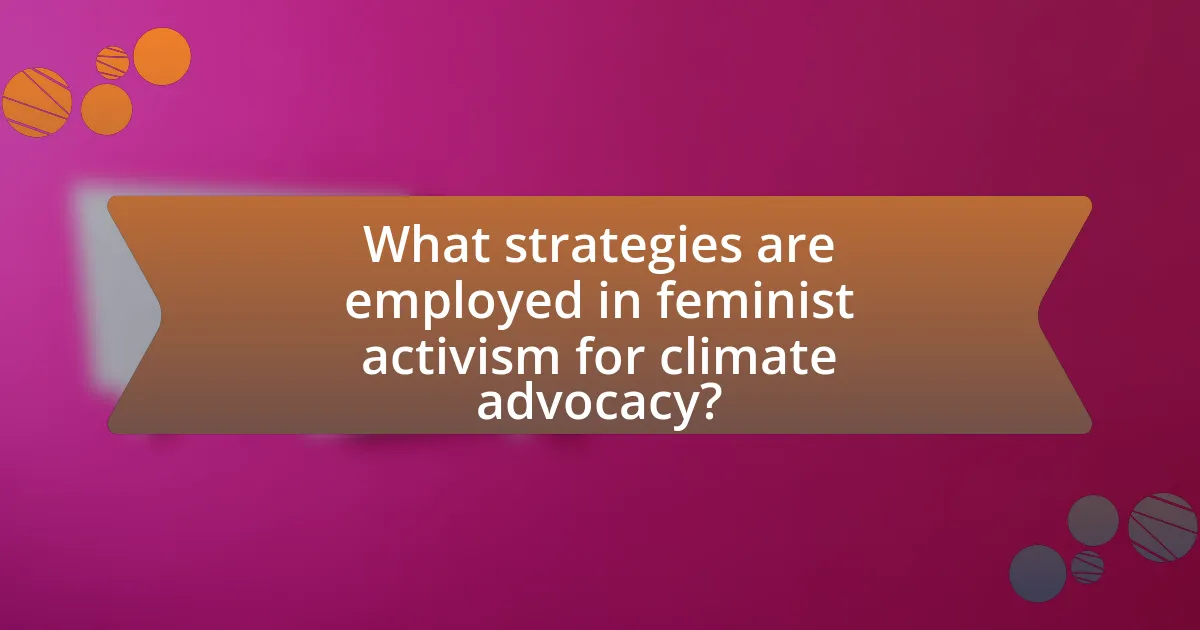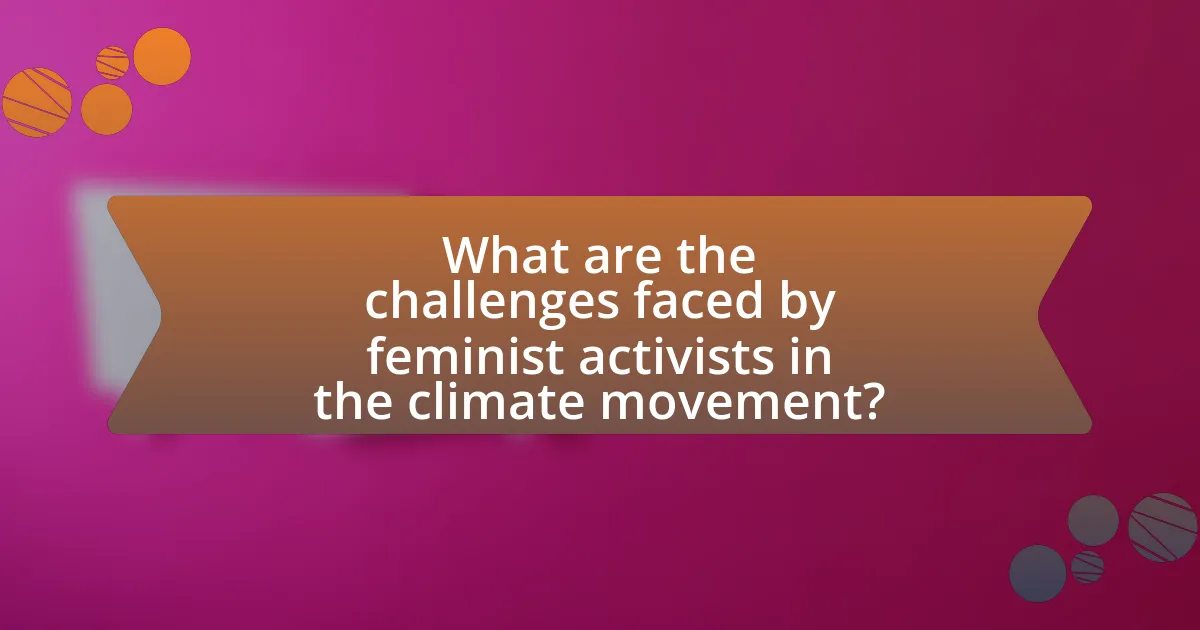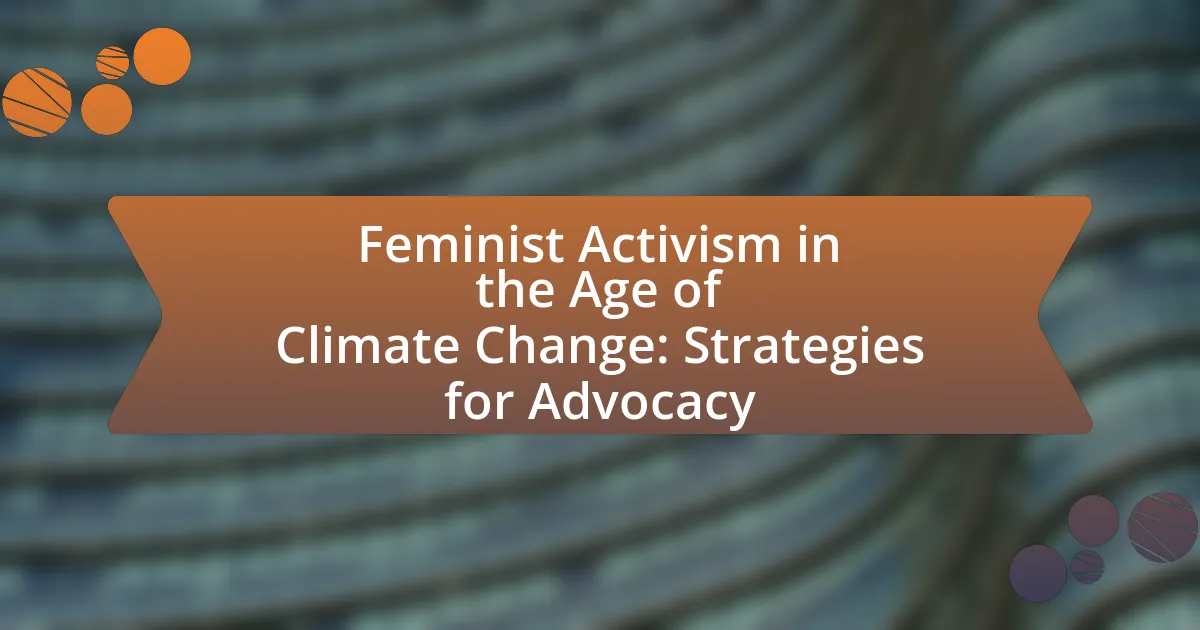Feminist activism in the age of climate change is a movement that merges gender equality with environmental justice, addressing the disproportionate effects of climate change on women and marginalized communities. The article explores the intersection of feminist activism and climate issues, highlighting the unique challenges women face, the historical roots of this activism, and the importance of gender-responsive climate policies. It discusses strategies employed in advocacy, including grassroots mobilization and policy influence, while emphasizing the need for inclusivity and intersectionality in climate movements. Additionally, the article outlines practical steps individuals can take to support feminist climate initiatives and the resources available for effective advocacy.

What is Feminist Activism in the Age of Climate Change?
Feminist activism in the age of climate change is a movement that integrates gender equality with environmental justice, emphasizing the disproportionate impact of climate change on women and marginalized communities. This activism seeks to address systemic inequalities by advocating for policies that consider gender in climate action, recognizing that women often bear the brunt of climate-related disasters and resource scarcity. For instance, studies show that women are more likely to be affected by climate-induced displacement and food insecurity, highlighting the need for inclusive decision-making processes in climate policy. By promoting women’s leadership and participation in environmental governance, feminist activism aims to create sustainable solutions that benefit all genders and foster resilience against climate change.
How does feminist activism intersect with climate change issues?
Feminist activism intersects with climate change issues by highlighting the disproportionate impact of environmental degradation on women, particularly in marginalized communities. Research indicates that women are often more vulnerable to climate-related disasters due to existing social inequalities, which can exacerbate their economic and social challenges. For instance, the United Nations reports that women make up 70% of the world’s poor, and they are more likely to be affected by climate change impacts such as food insecurity and displacement. Feminist activists advocate for inclusive policies that address these disparities, emphasizing the need for gender-responsive climate action. This intersection is crucial for creating equitable solutions that empower women and promote sustainable development.
What are the historical roots of feminist activism in environmental movements?
Feminist activism in environmental movements has historical roots in the intersection of women’s rights and ecological concerns, particularly emerging in the late 20th century. The 1970s marked a significant period when women began to articulate the connections between gender inequality and environmental degradation, as seen in the work of activists like Rachel Carson, whose book “Silent Spring” highlighted the dangers of pesticides and spurred environmental awareness. Additionally, the 1985 UN Women’s Conference in Nairobi emphasized the importance of integrating gender perspectives into environmental policies, further solidifying the link between feminism and environmentalism. This historical context illustrates how feminist activists have consistently advocated for sustainable practices that address both ecological and social justice issues, thereby shaping contemporary environmental movements.
How do gender perspectives influence climate change advocacy?
Gender perspectives significantly influence climate change advocacy by highlighting the distinct vulnerabilities and contributions of different genders in environmental issues. Women, particularly in developing countries, often bear the brunt of climate impacts due to their roles in resource management and household responsibilities. Research indicates that women are more likely to be affected by climate-related disasters, as they have less access to resources and decision-making power. For instance, the United Nations Framework Convention on Climate Change emphasizes the importance of gender-responsive approaches, stating that integrating gender considerations can enhance the effectiveness of climate policies and programs. This integration leads to more equitable and sustainable solutions, as women’s participation in advocacy ensures that diverse perspectives are represented, ultimately strengthening climate action efforts.
Why is feminist activism crucial in addressing climate change?
Feminist activism is crucial in addressing climate change because it highlights the intersectionality of gender and environmental issues, emphasizing that women, particularly in marginalized communities, are disproportionately affected by climate impacts. Research indicates that women are often the primary caregivers and resource managers in their households, making them vital to community resilience and adaptation strategies. For instance, the United Nations reports that women represent 43% of the agricultural labor force in developing countries, and their involvement in sustainable practices can significantly enhance food security and climate resilience. Therefore, integrating feminist perspectives into climate action not only promotes gender equality but also leads to more effective and inclusive environmental policies.
What unique challenges do women face in the context of climate change?
Women face unique challenges in the context of climate change, primarily due to existing gender inequalities that exacerbate their vulnerability. For instance, women often have less access to resources, education, and decision-making power, which limits their ability to adapt to climate impacts. According to the United Nations, women represent 70% of the world’s poor, making them more susceptible to the adverse effects of climate change, such as food insecurity and displacement. Additionally, women are frequently responsible for managing household resources, which becomes increasingly difficult as climate change disrupts water supply and agricultural productivity. These factors collectively hinder women’s resilience and capacity to respond effectively to climate-related challenges.
How can feminist activism contribute to sustainable solutions?
Feminist activism can contribute to sustainable solutions by advocating for gender equality in environmental policies and practices. Research indicates that women often play crucial roles in community-based resource management and sustainable agriculture, leading to more effective environmental stewardship. For instance, a study by the Food and Agriculture Organization (FAO) found that when women have equal access to resources, agricultural productivity can increase by 20-30%, which directly supports food security and sustainable development. Additionally, feminist activism emphasizes the intersectionality of social justice and environmental issues, ensuring that marginalized voices are included in decision-making processes, which can lead to more equitable and sustainable outcomes.

What strategies are employed in feminist activism for climate advocacy?
Feminist activism for climate advocacy employs strategies such as intersectional analysis, grassroots mobilization, and policy advocacy. Intersectional analysis highlights how climate change disproportionately affects marginalized groups, including women, thereby framing climate issues within broader social justice contexts. Grassroots mobilization involves organizing local communities to raise awareness and drive collective action, exemplified by movements like Fridays for Future, which emphasize youth and gender inclusivity. Policy advocacy focuses on influencing legislation to incorporate gender perspectives in climate policies, as seen in initiatives like the Gender Action Plan of the Paris Agreement, which aims to ensure women’s participation in climate decision-making processes. These strategies collectively aim to address both climate change and gender inequality, reinforcing the interconnectedness of these issues.
How do grassroots movements play a role in feminist climate activism?
Grassroots movements are essential to feminist climate activism as they empower local communities to advocate for environmental justice through a gendered lens. These movements mobilize individuals at the community level, fostering collective action that addresses both climate change and gender inequality. For instance, organizations like Women’s Earth Alliance and the Global Women’s Strike have successfully highlighted how climate policies disproportionately affect women, particularly in marginalized communities. By amplifying women’s voices and experiences, grassroots movements create a platform for inclusive dialogue and policy change, demonstrating that local activism can lead to significant global impacts.
What are some successful examples of grassroots feminist initiatives?
Successful examples of grassroots feminist initiatives include the Women’s March, which mobilized millions globally in 2017 to advocate for women’s rights and social justice, and the #MeToo movement, which empowered individuals to speak out against sexual harassment and assault. The Women’s March demonstrated significant impact by influencing policy discussions and increasing women’s representation in politics, while the #MeToo movement led to widespread cultural change and legislative reforms aimed at protecting victims of sexual violence. Both initiatives exemplify how grassroots organizing can effectively address systemic inequalities and promote feminist agendas.
How can community organizing enhance feminist climate advocacy?
Community organizing can enhance feminist climate advocacy by fostering collective action and amplifying marginalized voices. This approach enables women and gender minorities to unite around shared environmental concerns, leading to more effective advocacy efforts. For instance, studies show that grassroots movements, such as the Women’s Earth and Climate Action Network, have successfully mobilized communities to address climate issues while prioritizing gender equity. By leveraging local knowledge and building solidarity, community organizing empowers participants to challenge systemic inequalities and advocate for policies that reflect their unique experiences and needs in the context of climate change.
What role does policy advocacy play in feminist activism for climate change?
Policy advocacy is crucial in feminist activism for climate change as it seeks to influence legislation and policy decisions that address gender inequalities exacerbated by climate issues. Feminist activists leverage policy advocacy to ensure that women’s voices and experiences are integrated into climate policies, recognizing that women are disproportionately affected by climate change. For instance, studies show that women in developing countries are more vulnerable to climate impacts due to existing social and economic inequalities. By advocating for policies that promote gender-responsive climate action, feminist activists aim to create equitable solutions that empower women and enhance their resilience to climate change.
How can feminist activists influence climate policy at local and global levels?
Feminist activists can influence climate policy at local and global levels by advocating for gender-responsive climate strategies that address the unique impacts of climate change on women. They mobilize grassroots movements, engage in policy advocacy, and participate in international climate negotiations to ensure women’s voices are included in decision-making processes. For instance, the Women and Gender Constituency, which represents women’s rights organizations at the UN Framework Convention on Climate Change, has successfully pushed for the integration of gender considerations in climate action plans. This approach is supported by research indicating that gender equality can enhance climate resilience and sustainability, as seen in various case studies where women’s participation led to more effective environmental management.
What strategies can be used to engage policymakers in feminist climate issues?
To engage policymakers in feminist climate issues, strategies should include building coalitions among diverse feminist organizations, leveraging data-driven advocacy, and utilizing storytelling to highlight personal impacts of climate change on marginalized communities. Coalitions can amplify voices and create a unified front, as seen in initiatives like the Women’s Environment and Development Organization, which connects various feminist groups to influence policy. Data-driven advocacy, such as the use of reports from the Intergovernmental Panel on Climate Change, provides concrete evidence of the disproportionate effects of climate change on women, making a compelling case for policy change. Additionally, storytelling can humanize the statistics, as demonstrated by campaigns that share personal narratives from women affected by climate disasters, thereby fostering empathy and urgency among policymakers.

What are the challenges faced by feminist activists in the climate movement?
Feminist activists in the climate movement face several challenges, including intersectionality, marginalization, and resource allocation. Intersectionality complicates their efforts as they must address multiple layers of oppression, such as race, class, and gender, which can dilute their focus on climate issues. Marginalization occurs when feminist perspectives are overlooked in predominantly male-led climate discussions, leading to a lack of representation and voice. Additionally, limited access to funding and resources hampers their ability to mobilize effectively and implement initiatives. These challenges hinder the integration of feminist perspectives into climate policies, ultimately affecting the effectiveness of climate action.
How do intersectionality and diversity impact feminist climate activism?
Intersectionality and diversity significantly enhance feminist climate activism by ensuring that the voices and experiences of marginalized groups are included in the discourse. This inclusion allows for a more comprehensive understanding of how climate change disproportionately affects women, particularly those from diverse backgrounds, such as Indigenous, Black, and low-income communities. Research indicates that these groups often face unique challenges, such as limited access to resources and decision-making power, which can exacerbate their vulnerability to climate impacts. For instance, a study by the United Nations Framework Convention on Climate Change highlights that women in developing countries are more likely to be affected by climate-related disasters due to existing social inequalities. By integrating intersectional perspectives, feminist climate activism can advocate for policies that address these disparities, ultimately leading to more effective and equitable climate solutions.
What barriers do marginalized groups face within the climate movement?
Marginalized groups face significant barriers within the climate movement, including lack of representation, limited access to resources, and systemic discrimination. These groups often struggle to have their voices heard in decision-making processes, as evidenced by studies showing that women and people of color are underrepresented in climate leadership roles. Additionally, economic constraints hinder their ability to participate fully, as many marginalized individuals lack the financial means to engage in climate activism or access sustainable technologies. Research indicates that marginalized communities are disproportionately affected by climate change impacts, yet they receive less support and funding for adaptation and resilience initiatives, further entrenching their challenges within the movement.
How can feminist activists address issues of inclusivity in their work?
Feminist activists can address issues of inclusivity in their work by actively engaging diverse voices and perspectives within their movements. This involves creating platforms for marginalized groups, such as women of color, LGBTQ+ individuals, and those from low-income backgrounds, ensuring their experiences and needs are represented in advocacy efforts. Research indicates that inclusive movements are more effective; for instance, a study by the Women’s March Foundation found that diverse coalitions lead to broader public support and more comprehensive policy changes. By prioritizing intersectionality, feminist activists can enhance their impact and foster a more equitable society.
What are the potential risks and backlash against feminist climate activism?
Feminist climate activism faces several potential risks and backlash, including marginalization of voices, backlash from conservative groups, and internal divisions within the feminist movement. Marginalization occurs when feminist perspectives are sidelined in broader climate discussions, leading to a lack of representation for women’s issues in climate policies. Conservative groups often react negatively to feminist activism, framing it as a threat to traditional values, which can result in increased hostility and violence against activists. Additionally, internal divisions may arise as different feminist factions prioritize varying aspects of climate justice, potentially weakening collective efforts and causing fragmentation. These dynamics can hinder the effectiveness of feminist climate activism and pose significant challenges to achieving its goals.
How can activists prepare for and respond to opposition?
Activists can prepare for and respond to opposition by developing clear communication strategies, building coalitions, and anticipating counterarguments. Clear communication ensures that activists articulate their goals and values effectively, which can help mitigate misunderstandings and resistance. Building coalitions with like-minded organizations strengthens their position and provides additional resources and support during opposition. Anticipating counterarguments allows activists to prepare responses that address concerns and reinforce their message, making their advocacy more resilient. For instance, research from the American Psychological Association indicates that well-prepared activists are more likely to maintain public support during contentious debates.
What strategies can mitigate the risks associated with activism?
Strategies that can mitigate the risks associated with activism include building coalitions, ensuring legal protections, and utilizing digital security measures. Building coalitions with diverse groups enhances support and resources, reducing isolation and vulnerability. Legal protections, such as understanding local laws and securing permits, help activists operate within legal frameworks, minimizing the risk of arrest or harassment. Additionally, employing digital security measures, like encrypted communication and secure data storage, protects activists from surveillance and cyber threats. These strategies collectively create a safer environment for activists to operate and advocate effectively.
What practical steps can individuals take to support feminist activism in climate change?
Individuals can support feminist activism in climate change by actively participating in advocacy groups that focus on the intersection of gender and environmental issues. Engaging with organizations such as Women’s Earth Alliance or the Global Women’s Network for the Energy Transition allows individuals to amplify women’s voices in climate discussions. Additionally, individuals can educate themselves and others about the disproportionate impact of climate change on women, particularly in vulnerable communities, which is supported by research from the United Nations that highlights gendered vulnerabilities in climate crises. Supporting policies that promote gender equality in climate action, such as the inclusion of women in decision-making processes, is also crucial. By voting for representatives who prioritize these issues and advocating for gender-responsive climate policies, individuals can contribute to a more equitable approach to climate change.
How can individuals engage with local feminist climate initiatives?
Individuals can engage with local feminist climate initiatives by participating in community meetings, volunteering for events, and supporting local organizations focused on the intersection of gender and climate issues. Active involvement in these initiatives allows individuals to contribute to discussions, share resources, and collaborate on projects that address both environmental and feminist concerns. For instance, organizations like Women’s Earth Alliance work to empower women in climate action, demonstrating the effectiveness of grassroots movements in creating sustainable change.
What resources are available for those looking to advocate for feminist climate issues?
Resources available for advocating feminist climate issues include organizations, publications, and online platforms. Notable organizations such as Women’s Environment and Development Organization (WEDO) and the Global Alliance for Green and Gender Action (GAGGA) provide tools and networks for activists. Publications like “Feminist Climate Justice: A Handbook” offer insights and strategies for effective advocacy. Online platforms, including social media groups and websites dedicated to feminist climate activism, facilitate knowledge sharing and community building. These resources collectively empower advocates to address the intersection of gender and climate change effectively.
